Introduction
Lodging of cereal crops can be a major harvest challenge and can cause significant yield loss when it occurs early crop development. Variety selection, history of manure and organic matter levels, seeding dates and rates and disease infections all play a role in lodging susceptibility. There are significant varietal differences in resistance to lodging. The Ontario Cereal Crop Committee (OCCC) provides lodging ratings for varieties registered for sale in Ontario at www.GoCrops.ca. A lodging score of 0 to 9 is provided for each variety where a high score is undesirable.
Plant growth regulators (PGRs) can be applied to cereals to reduce plant height and increase stem thickness. This reduces the risk of lodging or delaying the onset and amount of lodging that occurs making it easier to manage and harvest wheat. PGRs can also improve yields, particularly where moderate to severe lodging occurs. There can also be significant differences in height between varieties.
Some PGRs can have impacts beyond reducing lodging or plant height. For example, some PGRSs can reduce apical dominance, increase tillering, or allow tiller’s to catch up in development. Some can also affect stomatal closure; often increasing yield slightly even when lodging is not an issue. However, under severe moisture stress, yields may be reduced for this same reason.
Cereal crops vary greatly in their response to PGR’s, and potential concerns for phytotoxicity (crop injury from PGR application). Weather extremes interact with most PGR’s, occasionally causing severe injury. When possible, avoid low (<5°C) temperatures, high (>25°C) temperatures, or wide temperature fluctuations (>20°C), the day before, the day of, and the day after application. Typically, winter wheat is far more tolerant than spring cereals, and spring wheat can be the most sensitive. Varietal differences also exist within species. Read and follow label directions carefully when using PGR’s.
When to Consider a Plant Growth Regulator Application
The decision to use a PGR is a function of variety selection, management, particularly the amount of nitrogen applied and the seasonal growing conditions (temperature, rainfall, etc.).
The use of a PGR will bring the most benefit when:
- The variety has a high lodging score (check ratings at www.GoCereals.ca) or there is high lodging potential;
- Winter wheat or barley are planted early and has a thick crop canopy;
- The field has a history of manure applications or high soil organic matter levels;
- There is high yield potential, and an intensive management program is used including early planting, high seeding rates and aggressive nitrogen rates.
The use of PGR has less value when:
- The variety has a low lodging rating and there is lower lodging potential;
- Split nitrogen applications are used in conjunction with lower nitrogen rates;
- There is lower yield potential due to a late planting date and significant tillering and growth is not a concern;
- High rates of manure are not used in current or previous years.
Winter Wheat Yield Response to Plant Growth Regulator Applications in Ontario
In trials conducted by Dr. Dave Hooker, at the University of Guelph, Ridgetown Campus between 2021 and 2023, there were varying yield and lodging score responses to PGR applications. In 2021, when there was moderate to severe lodging, there was a significant yield response to a PGR application compared to the untreated check (UTC) (Figure 1). Lodging scores were also significantly reduced by a PGR application compared to the UTC across all locations. Table 1 shows that at locations with moderate to severe lodging there was a significant yield benefit to a PGR application over the untreated check. All plots received 150 lb/ac of nitrogen (N).

In contrast, there was little to no lodging in 2022 and 2023 resulting in low yield responses in 2022 and no significant yield differences between the PGR treatments and UTC in 2023 (Figures 2 and 3).


Based on Ontario field research conducted to date, when there is a high risk of lodging, PGRs can be an effective tool at reducing or delaying the amount of lodging that occurs. Where moderate to severe lodging has occurred, PGRs can increase yields. However, when there is a low risk of lodging, you are unlikely to see a benefit and an economic response.
Plant Growth Regulator Selection
Currently there are a number of PGRs available in Ontario. Selecting a PGR is often based on whether the product can be applied according to its labeled application window and whether the goal is to reduce lodging by reducing plant height or promote fall growth.
Ethephon (Ethrel)
Ethephon, commonly known as Ethrel, is a PGR that when applied to wheat releases ethylene into cell tissue. Ethylene then causes a reduction in cell elongation and crop height which is effective in reducing lodging.
The application window for Ethephon is tight, with the ideal timing being between GS37 to 45 (flag leaf just visible up to boot just swollen). If the application window is missed and more than 10% of the awns have emerged Ethephon cannot be applied. Applying Ethephon outside of the ideal application window can cause crop damage and ultimately reduce yield. Scout fields regularly as the optimal timing approaches to ensure the product is applied at the appropriate time.
Chlormequat chloride (Manipulator)
Gibberellins are plant hormones that regulate various developmental processes, including the stimulation of cell elongation and cell division which gives plants their height. Chlormequat chloride, commonly known as Manipulator, is a plant growth regulator that inhibits the early stages of gibberellin production in winter wheat. The application of chlormequat chloride to wheat results in a reduction in plant height while the stems are thickened. This in turn results in a reduction in lodging.
The full application window for chlormequat is GS 12-39. However, the ideal timing is GS 30-32 (stem elongation – 1st to 2nd node). In split applications (spring and winter wheat, durum, barley and oats) the the first application should be made at GS 21 – 23 (1 to 3 tillers) and the second application at GS 39 (flag leaf visible).
Trinexapac-ethyl (Moddus)
Trinexapac-ethyl is also a PGR that inhibits the production of gibberellic acid. This causes the internodes to shorten and stems to thicken resulting in a reduction in lodging.
The full application window for trinexapac-ethyl is GS 30-39. However, the ideal application window is GS 30-32 (stem elongation – 1st to 2nd node). In split applications (spring wheat, durum, barley and oats) the the first application should be made at GS 21 – 24 (1 to 4 tillers) and the second application at GS 37-39 (flag leaf just visible to ligule of last leaf visible).
Gibberellic acid, GA3 (Proliant)
Gibberellic acid (Proliant) is slightly different from some of the other types of PGRs available. Unlike other PGRs, gibberellic acid is used to enhance early growth in winter wheat rather than hinder it. Gibberellic acid elongates plant cells and encourages cell division. The result is more robust plants that can handle stress (i.e. cold temperatures and drought).
Gibberellic acid can be applied up to GS30 (stem elongation). However, the biggest benefit has come from when it is applied in the fall because gibberellic acid is generally used to promote early growth of the crop. While the early growth of the plants is enhanced, lodging is not a concern as long as it is used at the correct time.
If choosing to use a plant growth regulator, always follow the label for application recommendations.
| Product | Application Window | Ideal Application Stage | Function |
| Ethephon | GS 37 – 45 | GS 37 (flag leaf) | Reduces cell elongation and plant height |
| Chlormequat chloride | GS 12 – 39 | GS 30 – 32 | Reduces cell elongation and plant height |
| Trinexapac-ethyl | GS 30 -39 | GS 30 – 32 | Reduces cell elongation and plant height |
| Gibberellic acid | Up to GS 30 | Fall application | Encourages cell division, resulting in a more robust plant |